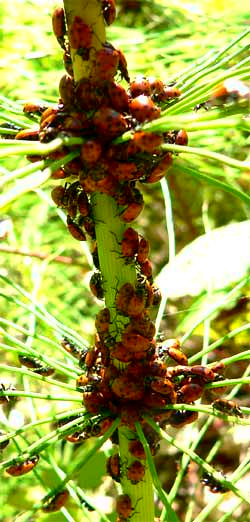 It's hard to miss Ladybugs, which
some people call "ladybirds" and even "ladybeetles."
It's hard to miss Ladybugs, which
some people call "ladybirds" and even "ladybeetles."
For example, on one recent morning I was hiking along a stream and saw what you see at the right. Horsetail plants were growing there and at every node on each horsetail dozens of ladybugs were clustered just as you see, and there were hundreds of such clusters. Clustering like this is something ladybugs do and sometimes you see clusters much larger than these -- with thousands of ladybugs! Sometimes they cluster inside homes, if they can get in. This clustering helps them keep one another warm and maybe the stink they make when altogether also keeps predators away. Adults often overwinter in clusters, sometimes in tremendous numbers.
Later in the morning as the air warmed the critters became restless and some of them started wandering around. By mid afternoon all the ladybugs had flown away, but in a nearby open area so many were flying around it was hard to keep them out of my hair!
LADYBUG CLASSIFICATION
Just by looking you may be able to guess that ladybugs are beetles -- members of the order Coleoptera. One thing to keep in mind is that there are many kinds of ladybug, some of them in entirely different genera! Worldwide, about 4500 species of ladybirds are known, with 96 currently reported just from Florida in the US. In fact, the world of ladybugs is so great and complex that ladybugs have their own family, the Ladybug Family, or Coccinellidae.
Some of the things that make a ladybug a ladybug are:
- roundish shape
- nearly flat on the bottom but very high on top
- head partly or totally concealed from above (by the pronotum)
- usually reddish, orange or yellow with black spots
- antennae short, club-shaped
MULTICOLOR ASIAN LADYBEETLES
 The
ladybug at the left is the Multicolor Asian Ladybeetle, Harmonia axyridis.
This species is only about ¼-inch long (6 mm), which is typical. Multicolor Asian
Ladybeetles, though in many places by far the most abundant member of the family, were
introduced into the US from eastern Asia. Though only first collected in natural areas in
the US in Louisiana in 1988, already the species occurs in all states. Many of the
introductions were intentional, because in its Asian homeland it's an important predator
of scale and aphid pests on trees. Was introducing this species a good idea? Many
homeowners finding masses of hundreds or thousands of them overwintering in their attics,
behind their living-room curtains, and many other places, wouldn't say so. You can read about their natural history here.
The
ladybug at the left is the Multicolor Asian Ladybeetle, Harmonia axyridis.
This species is only about ¼-inch long (6 mm), which is typical. Multicolor Asian
Ladybeetles, though in many places by far the most abundant member of the family, were
introduced into the US from eastern Asia. Though only first collected in natural areas in
the US in Louisiana in 1988, already the species occurs in all states. Many of the
introductions were intentional, because in its Asian homeland it's an important predator
of scale and aphid pests on trees. Was introducing this species a good idea? Many
homeowners finding masses of hundreds or thousands of them overwintering in their attics,
behind their living-room curtains, and many other places, wouldn't say so. You can read about their natural history here.
LADYBUG FOOD
Both adults and larvae of most species feed on small, fairly soft-bodied insects such as aphids, scale insects and mites. Since these insects feed on garden plants causing many problems to gardeners, this makes ladybugs very welcome in any garden. In fact, in many garden catalogs and on the Internet you can order boxes full of thousands of ladybugs to be released in your own garden, in the hope that they'll control the numbers of aphids, scale insects and other pests!
THE WORD LADYBIRD
I grew up calling these insects "ladybugs" but most books seem to refer to them as "ladybirds." The dictionary says that the latter word is derived from "bird of Our Lady." Most people are pretty sure that "Our Lady" means the Virgin Lady, and one theory is that the people who named our little beetle "ladybird" had a species ornamented with seven spots, and the namers saw in these seven spots "the seven sorrows of the Virgin Mary." Also it's possible that in the old days people simply thought that ladybugs were so pretty that they deserved to be associated with the Virgin Mary.
But, what about the "bird" part of "ladybird"? A good guess is that people just thought that a "bird" was more appropriate to be associated with The Virgin than a "bug."